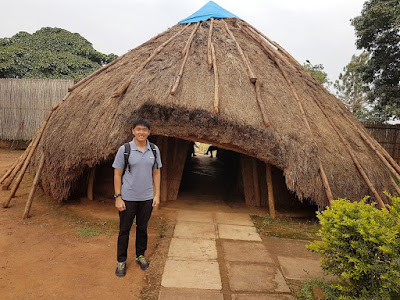Thanks for staying tuned to my coverage of Shinjuku Gyoen, one of Tokyo's largest and most popular parks. In Part 2, we shall look into its French formal garden and greenhouse. As a recap,
Part 1 covers about mainly Mother and Child's Forest, Japanese traditional garden and English landscape garden.
Compared to the Japanese and English counterparts, the French formal garden is as big, but equally beautiful nonetheless.
 |
| I was blown away by the sight of the leafless sycamore tree. |
 |
Unfortunately, not many flowers had bloomed when we were there in early spring.
|
A panorama shot? Here you go!
Alas, we couldn't witness the beauty of the rose beds in full bloom.
 |
| Sally Holmes is a white shrub rose cultivar. |
From there, we tired to walk through different paths from where we came from to reach the greenhouse.
 |
That looks like a nice place to live in.
|
We found ourselves at another rest house, where we decided to buy some snacks to bring home.
Here are more photos of the English landscape garden nearer to the greenhouse.
 |
| Such a lovely sight of pink and white cherry blossoms! |
 |
Make a guess whether those are real flowers.
|
Near the greenhouse, there's a historical rest house built in 1896 for the imperial family, which survived World War II while a huge portion of Shinjuku Gyoen was destroyed. It's open to the public only on two or three days every month.
I know I've been saying the singular form of greenhouse all along to refer to the biggest one, which is more of a biodome, within the premise of the park. There are actually quite a number of smaller ones too.
 |
What remains of the pre-war greenhouse that was completed in 1875...
|
I shall let the photos of the huge greenhouse do the talking.
 |
The spacious, modern greenhouse was completed in 2012.
|
 |
Commonly known as moth orchids, Phalaenopsis is indeed derived from phalaina,
an ancient Greek word that literally means 'a kind of moth'.
|
 |
| Does anyone know the name of that hairy flower? |
 |
Nymphaea grows well in neutral to alkaline water with temperatures no cooler than 24 degree Celsius.
|
As of 2016, the greenhouse displayed more than 1,700 tropical and subtropical plant species.
 |
To be honest, I wasn't expecting an overhead bridge inside the greenhouse.
|
 |
"If we're growing, we're always going to be out of our comfort zone." ~ John Maxwell
|
 |
Banana blossoms are nice to eat, don't you think?
|
 |
I recall sweating a little bit as it was pretty warm inside.
|
I was intrigued by the various tropical pitcher plants.
 |
Did you know that those are called sako ni Hudas (lit. Judas' money bag) in the Philippines?
|
Back near the entrance, I spotted a section where many potted plants are displayed.
 |
| Ponderosa lemon is a citrus hybrid of a pomelo and a citron. |
 |
Just a thought... How much water do all the plants there drink in a day?
|
I really enjoyed my morning at the park.
 |
A two-headed monster?
|
Allow at least two to three hours to explore Shinjuku Gyoen.

































































Comments
Post a Comment